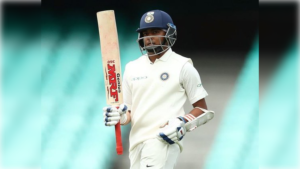
Ashok Namboodiri
Every time Indian cricket seems to have moved on from Prithvi Shaw, he finds a way to remind us that talent like his doesn’t disappear; it merely lies dormant, waiting for one audacious innings to announce its return. On his birthday today, it’s hard not to marvel at the sheer resilience of a cricketer who refuses to be forgotten.
Shaw began the 2025 Ranji Trophy season with a whimper…a duck against Kerala. For most players, that would’ve been a shaky start. But Shaw being Shaw, the story changed within days. He followed the failure with a defiant 75 in the second innings, helping his side salvage a draw. And then came the thunderclap: a blistering 222 off just 156 balls against Chandigarh, featuring a century in merely 72 deliveries. It wasn’t just his first ton of the season, it was the third-fastest double century in Ranji Trophy history. The knock was a reminder that while form may dip, class, intent, and self-belief don’t vanish.
That innings summed up everything about Shaw’s career – a mix of fearlessness, flair, and ferocious talent. Few players in Indian cricket’s domestic circuit can dominate bowling attacks the way he does when he’s “on.” His back-foot punches have the power of a whip crack, and his cover drives retain the swagger of a boy who believes he was born for the big stage. Yet, for all the brilliance, Shaw’s story has been punctuated by moments of frustration – disciplinary lapses, fitness issues, and lost opportunities that have kept him on the periphery of the national setup.
The paradox of Prithvi Shaw is that he’s simultaneously one of the most gifted and most polarising young batsmen India has produced. His journey from leading India to victory at the 2018 U-19 World Cup to scoring a century on Test debut seemed to chart a straight line to greatness. But somewhere along the way, the graph dipped – injuries, attitude concerns, and inconsistent communication from management combined to push him out of the spotlight. Every comeback since has had to be louder, faster, more undeniable than before.
In that sense, Shaw is not alone. Cricket history is strewn with young prodigies who fell victim to their own impetuousness. Vinod Kambli remains the most tragic parallel – a batsman of divine touch who couldn’t match the discipline that international cricket demanded. Ambati Rayudu fought perception battles for years despite his immense skill.
There’s also a deeper systemic question here: does Indian cricket have a structured mechanism to channel such volatile, explosive talent? In countries like Australia or England, players with similar reputations – think Ben Stokes in his early years or Alex Hales – found redemption through a mix of tough love, mentoring, and clear communication. In India, where the bench strength is overflowing, redemption is harder to come by. The moment a player falters, another waits in line.
In an era where fitness regimes, team cultures, and social media scrutiny leave little room for rebellion, Shaw represents a rare throwback – a player who lets his bat speak in bursts of defiance. Domestic cricket has become his confessional space, where each innings is an apology, a declaration, and a challenge rolled into one. His 222 against Chandigarh wasn’t merely about numbers; it was about redemption, about saying, “I’m still here.”
The challenge for Indian cricket now is to balance its overflowing talent pipeline with empathy. Every system needs its mavericks. Shaw may not fit into the mould of the perfect professional, but he embodies the restless creativity that keeps the game alive. And perhaps, with age and perspective, he can transform that restlessness into something enduring.
Follow Revsportz for latest sports news
